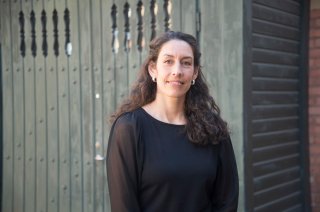
category_news
‘The blue economy should become far more diverse’
Globally, marine seafood trade is dominated by a few fish species, like tuna and salmon, shrimp and whitefish, many of which are fished in unsustainable ways. Aquatic foods have an important role to play in making our food systems and diets far more sustainable, but to leverage that potential, we need to diversify the seafood sector and learn to consume a wider variety of aquatic species, says Beatrice Crona.
Crona is the keynote speaker at the upcoming Dies Natalis of WUR on the 8th of March. She is a professor of sustainability sciences in Sweden, Science Director of the Stockholm Resilience Center and a leading expert on transdisciplinary approaches to global marine sustainability, including aquatic food systems. ‘If we open up and utilise the locally available diversity of aquatic species, we have the potential to build resilience into our food systems, instead of relying on only a few globally commodified species, produced by a handful of countries.’
Low environmental footprints
‘We are catching or farming over 2,500 types of aquatic species. The small-scale
fisheries and aquaculture sector is already hugely diverse, but most of these
species are only consumed at very local scales. Yet some of them could be
veritable superfoods. For example, mussels, which have low environmental footprints, have the potential to be fished sustainably and can even contribute to reducing eutrophication. Likewise, algae and seaweeds can most likely also play a much bigger role in our food systems in the future.’
Blue Food Assessment
Together with a team of international colleagues forming part of the
Blue Food Assessment, Crona recently published an article in Nature, which
concludes that aquatic foods have four broad and important roles to play to
make future food systems more sustainable, healthy and just. Specifically, they
can help reduce nutrient deficiencies, limit cardiovascular diseases, limit CO2 emissions, and also help sustain and make resilient local cultures, livelihoods and economies. But aquatic foods can only contribute to food system ambitions if we solve persistent problems like overfishing and pollution.
How can we provide food for 10 billion people in a sustainable manner?
‘In our part of the world, in countries like Sweden and The Netherlands, where most people are relatively well-nourished, we can change our meat-based diets to
plant-based diets, including only limited amounts of seafood. But in other
parts of the world, people would benefit tremendously from a relatively minor
increase in the consumption of aquatic food. Since we are unlikely to have
enough aquatic proteins for 10 billion people to use as a replacement for
terrestrial meat, social justice becomes an important issue when we consider
how blue foods can contribute to sustainable food systems in the future.’
How did you get acquainted with this field of study?
‘I started my scientific journey as a PhD student in marine ecology, to understand the role of coral reefs and mangrove forests in Kenya as nursery grounds for fish’, says Crona. ‘I quickly understood that my ecological research would not solve the problem of overfishing. So I changed my focus to also incorporate sociology. Whom were fishers talking to and exchanging knowledge with? I soon found that the fish traders held important positions in the local networks of fishing communities and controlled much of the fishing through debt and by channeling the pressures of international trade into small-scale fishing communities ill-equipped to deal with such economic powers.’
Since then, Crona has been studying the global governance and trade of sea food from various angles. She calls herself an ‘undisciplinary’ scientist. ‘I combine different theories and methods from the natural and social sciences and apply them to find answers and solutions.’
How do you judge the MSC (Marine Stewardship Council) certification to govern sustainable trade of seafood?
‘When MSC emerged 30 years ago, it had a very important role in pushing sustainability in global sea food markets. But is it enough? I don’t think so. The reason is that MSC certification has become very formulaic, with strict rules and lots of data requirements that many small-scale fisheries cannot comply with. This makes it difficult and expensive for local fishers to apply for a MSC label, yet 40% of harvested seafood globally is provided by small-scale producers. As such, MSC has become primarily a tool for guiding large-scale industrial seafood production.’
‘To complement this, we need a different approach, which can evaluate the sustainability of smaller-scale operators from their local contexts and make certification schemes less rigid and more inclusive for fishing communities. Wageningen has great research on this.’
You also try to involve investors in sustainable sea food production and trade. How?
‘If you want to improve the stewardship of international seafood producers and traders, you have to ask yourself: what drives these companies? The answer is: money, and most of that money comes from the financial sector. So we have done work to link sustainability of the seafood industry to private investments, and map the mechanisms by which investors can influence corporate seafood sustainability. Through ownership and engagement in companies in their investment portfolios. But in the seafood sector, many of the largest companies are privately owned, and we therefore find that corporate banks that offer credit are likely to have the biggest potential to pressure companies into adopting sustainability goals and act on them. Banks can do this concretely, by offering more attractive green loans to actors who shift practices, and increase interest rates for those that do not. We already see progress in this domain, as the financial industry is beginning to look into using the FAO Code of Conduct for Responsible Fisheries in their policies, as well as implementing hard policies against forced labor on fishing fleets.’